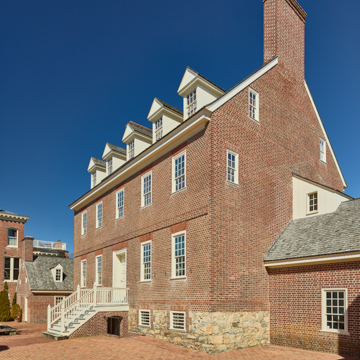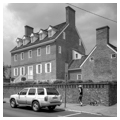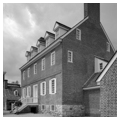This was the home of William Paca, attorney, signer of the Declaration of Independence, and a Maryland governor. Within days of his marriage to Mary Chew, Paca commenced construction of this large and imposing house that he is believed to have designed. Paca chose the newly introduced five-part plan that first appeared c. 1760 in the now much-altered Bordley-Randall House. The house included a prominent two-story rear tower, a relic of colonial architecture that distinguishes it as among the earliest of Maryland’s many five-part houses. The tower provides a panoramic view of the formal garden.
Other traits characteristic of Annapolis architecture are its raised, galleted, stone foundation, facade laid in the fashionable header bond of the period, and large gable-end slab chimneys that lend greater height and prominence. The interior manifests a traditional Georgian center-passage plan with the stair to one side. The two rooms flanking the passage on the street front served as parlor and drawing room. The dining room overlooks the rear garden, with a small study behind the stair and a kitchen in the southeast wing.
Paca House was dramatically altered in 1901 with its conversion as the Carvel Hall Hotel and the addition of a massive wing extending into the garden. In the 1960s, Historic Annapolis purchased the house and the State of Maryland the formal terraced garden. Featuring rose, holly, and boxwood parterres in geometric patterns, a Chinese latticework bridge, and a summerhouse, the garden restoration was based on its appearance in the background of Charles Willson Peale’s 1772 portrait of Paca. The house was opened to the public following an extensive 1970s restoration.
References
Miller, Marcia and Orlando Ridout V, eds. Architecture in Annapolis: A Field Guide. Crownsville, MD, and Newark, DE: Maryland Historical Trust and the Vernacular Architecture Forum, 1998.




























